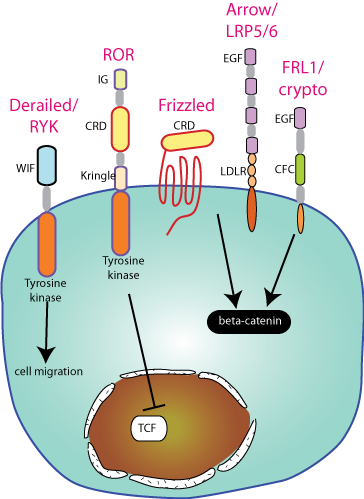
Alternative receptors for Wnt proteins (October 2008)

Beyond the well known receptors Frizzled and LRP, there are several other transmembrane proteins that act as specific receptors for Wnt proteins. In several cases, these receptors play a role in alternative Wnt pathways.
The Derailed/RYK proteins are transmembrane tyrosine kinases. They have a Wnt binding domain similar to the WIF proteins, a group of secreted Wnt binding factors (Hsieh 1999). In Drosophila, Derailed interacts with DWnt5 to mediate axon guidance, Yoshikawa 2003) and in salivary gland migration (Harris, 2007). There is also evidence in C.elegans (Lin-18, (Inoue 2004) and in mammals (RYK, Lu et al 2004) for Wnt interaction with these receptors. RYK can interact with Dsh ( Lu et al 2004). and function in Wnt/beta-catenin/TCF signaling but in other contexts, these pathways are not linked.
The ROR transmembrane tyrosine kinases can also bind to Wnts, using a CRD motif similar to that of the Frizzleds (Kani et al, 2004, Mikels 2006) This interaction is conserved in evolution, also found in C. elegans (Forrester, 2004). Wnt5a can specifically bind to Ror2 and thereby inhibit Wnt/beta-catenin/TCF signaling (Mikels 2006). The mechanism of inhibition is not clear however. Evidence in Xenopus indicates that Wnt5a signals through Ror2 to control expression of cadherins and convergent extension (Schambony 2007)
A member of the FRL1/Crypto class of receptors has been found to mediate Wnt signaling in Xenopus. Wnt11 is a maternally derived axis inducer, signaling through a Frizzled plus FRL1/Crypto (Tao et al , 2005).
From these and other data, a picture emerges of various Wnts binding to different classes of receptors. The outcome of signaling is then regulated by receptor context and is not intrinsic to a particular Wnt. Wnt5a for example can signal to the Wnt/beta-catenin/TCF pathway when interacting with Frizzled4 and LRP5 (Mikels 2006), as well as through ROR2. Wnt11, long viewed as a "non-canonical" Wnt is clearly also able to signal via beta-catenin in a Frizzled-FRL dependent manner (Tao et al , 2005).
It should also be mentioned that receptor context plays a role in the distinction between Frizzled-mediated planar polarity signaling and Wnt/beta-catenin signaling in Drosophila. The Wnt co-receptor Arrow is genetically necessary beta-catenin (armadillo) signaling, but is dispensable for planar polarity (Wehrli, 2000).
These receptors and pathways are reviewed in:
van Amerongen R, Mikels A, Nusse R. Alternative wnt signaling is initiated by distinct receptors. Sci Signal. 2008 Sep 2;1(35):re9.
Mikels, AJ. and Nusse, R. Wnts as ligands:processing, secretion and reception. Oncogene 25, 7461-7468 (2006)
Gordon MD, Nusse R. Wnt signaling: multiple pathways, multiple receptors, and multiple transcription factors. J Biol Chem. 2006 Aug 11;281(32):22429-33.
Green, J. et al. (2008) Ror receptor tyrosine kinases: orphans no more. Trends Cell Biol. 536-44. Epub 2008 Oct 9